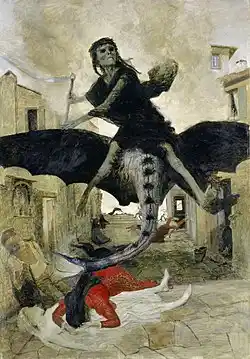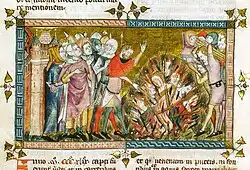
The Black Death (bubonic plague) is the name given to the first major and most virulent wave of the bubonic plague to strike Europe. Having travelled across Asia on the foot of the Mongolian conquests, the plague reached Europe in the middle of the 1340s. It was at its worst between 1346 and 1353, peaking in 1348, 1349 and 1350. The plague is estimated to have killed between 25 and 30 million people in Europe out of an estimated population of between 70 and 80 million people at that time. In some of the worst hit regions such as the urbanized and more densely populated Italian city states it killed upwards of half of the population. The wider implications of it across Eurasia between the thirteenth and fifteenth centuries were even worse, with estimates of total fatalities ranging anywhere from 75 to 200 million. The plague had implications for demography across Europe and caused substantial migration.[1]
The Black Death chronology of eventsThe Black Death chronology of events
Eurasia had already experienced major plague pandemics in ancient times, notably in the middle of the second century when the Antonine Plague killed roughly 10% of the population of the Roman Empire and the sixth century when a series of waves of plagues arrived to the continent. The latter was so destructive that it is termed the First Plague Pandemic. The Second Plague Pandemic was that which is associated with the Black Death and which occurred in the late medieval period.[2]
The bubonic plague is caused by the Yersinia pestis bacterium. It is an airborne bacterium which can be transmitted across large distances if it becomes attached to fleas like the ones which then attached themselves to rats that carried the disease to Europe in the fourteenth century. It began its movement towards Europe from the Asian Steppe in the early thirteenth century as the Mongol armies of Genghis Khan burst out of the region and conquered most of Asia. Some of its spread was owing to an early form of biological warfare, as the corpses of the deceased were catapulted into cities that were under siege by the Mongols.[3]
The entry-point into Europe was probably on rats which boarded Genoese merchant ships in the Crimea region where the Genovese had extensive trading concessions and colonies in the 1340s. It then arrived to Italy and spread rapidly across the continent, being present in Iberia, France, England, Ireland and southern Germany by 1348 and 1349, infiltrating Scotland, northern Germany, Poland, Denmark and southern Sweden by 1350 and finally reaching Finland, the Baltic States region and Russia in 1351 and 1352. It is not hard to see how it spread so quickly, with modern assessments suggesting that even in an age before mechanized travel it could move more than a mile per day on average simply by jumping from host to host.[4]
The plague is a brutal disease. It begins as a fever, headache and vomiting after exposure and incubation, after which ‘buboes’ (thus the name bubonic plague) begin to form where some of the lymph nodes are on the body on the neck, armpits and near where the flea that carried the bacterium bit an individual. As it progresses the ‘buboes’ turn blackish and will often burst open. At least 30% of those who are contaminated will die without modern medical intervention and the figure was substantially higher during the worst of the Black Death in Europe in the 1340s and 1350s.[5]
Because of its lethality, it is estimated that between 25 and 30 million people died from it in Europe between 1346 and 1353 out of a total population of 70 to 80 million. Mortality levels were highest in countries like Italy which were highly urbanized by comparison with regions like Finland or Poland. Equally, within individual countries, specific localities experienced greater levels of infection and death. For instance, London and other towns in England were far worse hit than remote, less densely populated parts of the north of the country.[6]
Extent of migration associated with the Black DeathExtent of migration associated with the Black Death
The impact of the Black Death on migration across Europe was considerable. In the twelfth and thirteenth centuries Europe had gone through a period of political, social and economic revitalization. This had led to the growth of towns and cities, with trade guilds forming, commerce expanding, the first universities being established and urban life general flourishing. The Black Death curbed this process initially. People fled from the towns and cities when they realized that people were dying there in greater numbers. Although medical knowledge was limited at the time, people had a general idea of the benefits of quarantine (the word comes from quarantina, the Italian term for 40-days quarantine which was imposed on merchant ships entering ports as a result of the plague outbreak) and of avoiding exposure to others who had it. However, despite the psychological aversion to congregating in large urban centers which had been wrought by the plague, demand for goods produced in urban centers increased significantly after the Black Death as the population was so low. As a consequence, in the long term, the plague actually led to urban growth.[7]
Demographic impact of the Black DeathDemographic impact of the Black Death

Eventually people returned to the urban centers of Europe and the continent’s cities experienced exponential growth from the fifteenth century onwards. In this light, probably the most lasting demographic impact of the Black Death was actually on the map of Jewish settlement across Europe. When the Black Death struck in the 1340s, there was already growing anti-Semitism in many European countries. For instance, King Edward I of England had ordered the expulsion of the Jewish population of England in 1290, while there had periodic royal announcements of expulsion orders from France. In the tumult of the 1340s and 1350s people sought out groups to blame for the horror that had befallen Europe with the plague. Their targets were generally social outsiders who were now accused in huge numbers of witchcraft that had caused the plague and Jewish people. Consequently, the second half of the fourteenth century and into the fifteenth witnessed a deepening official and social persecution of the Jews of Western and Central Europe.[8] As this happened, huge numbers of Ashkenazi Jews migrated eastwards to the Kingdom of Poland and the Grand Duchy of Lithuania where greater toleration was offered to them, perhaps in part because this was one of the few parts of Europe that had escaped massive damage during the plague outbreak. Consequently, the foremost impact of the Black Death in the long run was in the movement of Europe’s Jews towards the east of the continent.[9]
See alsoSee also
Explore more about the Black DeathExplore more about the Black Death
- Yizkor Book Name Index from JewishGen record collection on MyHeritage
- Lithuanian-Jewish Records from LitvakSIG, 1795-1940 record collection on MyHeritage
- The Black Death at history.com
References
- ↑ Black Death. History Channel
- ↑ What Rome Learned From the Deadly Antonine Plague of 165 A.D.. Smithsonian Magazine
- ↑ How the Black Death Started in Asia. ThoughtCo
- ↑ Fast and lethal, the Black Death spread more than a mile per day. National Geographic
- ↑ Plague. World Health Organization
- ↑ THE BLACK DEATH: THE PLAGUE, 1331-1770. University of Iowa
- ↑ Nico Voigtlaner and Hans-Joachim Voth, ‘The Three Horsemen of Riches: Plague, War, and Urbanization in Early Modern Europe’, in The Review of Economic Studies, Vol. 80, No. 2 (283) (April, 2013), pp. 774–811.
- ↑ The Black Death (1348 - 1350)
- ↑ Piotr Guzowski, ‘Did the Black Death Reach the Kingdom of Poland in the Mid-Fourteenth Century?’, in The Journal of Interdisciplinary History, Vol. 53, No. 2 (2022), pp. 193–223.

